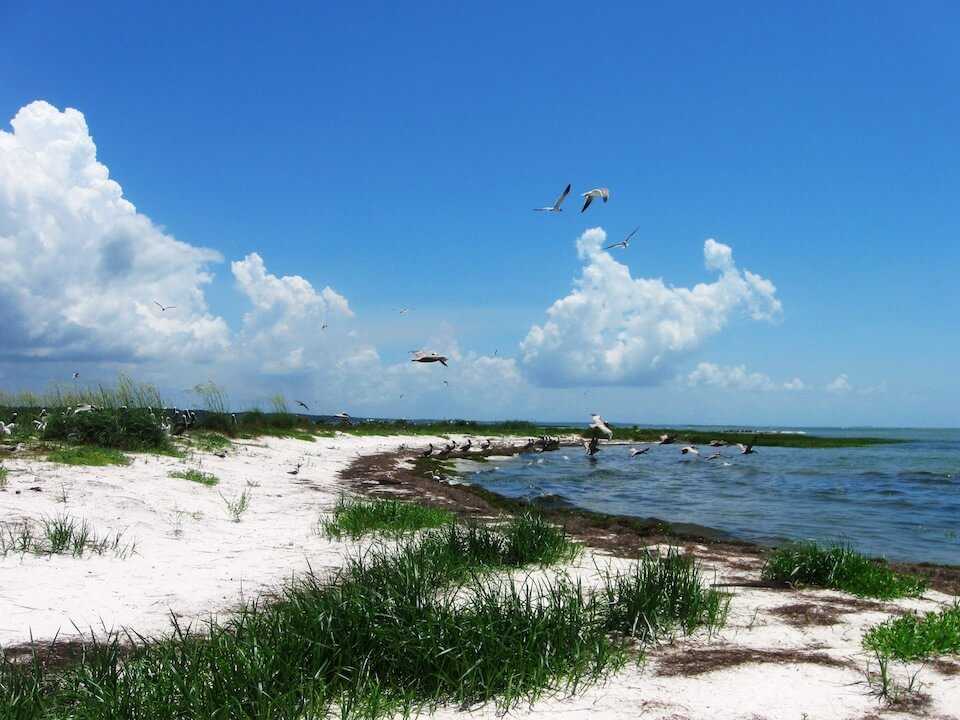- Beach and Surf Zone
Beach and Surf Zone
within Coastal Uplands
Vulnerability:
This habitat was not assessed for vulnerability
General Information
The surf zone is the long, often narrow strip of sand and shells between the tides. Daily flooding by salt water and moderate- to high-energy waves prohibit plant growth except for some inconspicuous algae. The surf zone is an important nursery and feeding habitat for many species of fish. Low-energy beaches provide important spawning habitat for horseshoe crabs and feeding habitat for multiple species of shorebirds. Beaches are also vital nesting sites for many sea turtles and support numerous other mammals and invertebrates.
Species:
Area
- 9,866 hectares within Florida (modeled)
- 4,089 hectares (41%) is located on public lands
Area impacted by up to 3 meters sea level rise:
Climate Impacts
The beach and surf zone habitat is likely to have 69% of the current area inundated by 1 m of sea level rise and 91% inundated by 3 m of sea level rise. As sea level rises, it may be that new beach areas are formed, replacing other habitats as they become inundated; however, if and where this may happen depends on many variables, such as the geomorphology of the area or the existence of barriers to formation (e.g., hardened shoreline).
More information about general climate impacts to habitats in Florida.
Climate Impacts to Species
The loss of beach/surf zone habitat will impact many species that depend on this habitat such as mole skinks, terrapins and shorebirds. The Cedar Key mole skink depends on the wrack (plant material washed up on the beach) found along the beaches. The surf zone provides foraging habitat for many species of shorebirds.
More information about general climate impacts to species in Florida.
Other Non-climate Threats
- Channel modifications
- Chemicals and toxins
- Disruption of longshore transport of sediments
- Fishing gear impacts
- Incompatible recreational activities
- Industrial spills
- Invasive animals
- Roads, bridges and causeways
- Shipping lanes
- Shoreline hardening
More information about climate change interactions with existing threats and stressors in Florida.
Adaptation Strategies
Protection
- Identify and protect locations where native species may shift or lose habitat due to climate change impacts.
- Maintain linkages between undeveloped areas.
- Create setbacks or rolling easements.
- Preserve undeveloped and vulnerable shoreline.
Restoration
- Reduce/eliminate access to critical breeding, nesting, foraging and wintering areas as they become more stressed due to impacts from climate change.
- Implement living shorelines to reduce erosion from storm events.
- Redesign or mitigate existing physical barriers or structures that impede movement and dispersal within and among habitats.
- Develop corridors between undeveloped areas.
- Restore and/or protect coastal vegetation to reduce the impact of increased disturbance events (intense storms, increased erosion) and encourage aeolian sand capture
- Reduce impacts from points of access (e.g., paths, boardwalks).
Planning
- Identify areas particularly vulnerable to loss or transition under climate change and develop management strategies and approaches for adaptation.
- Coordinate with County staff to incorporate sea level rise adaptation strategies into comprehensive plans and post-storm redevelopment activities
- Modify conservation management priorities to include species and habitat adaptation to the effects of climate change.
- Incorporate altered or restricted points of access into plans to accommodate impacts from climate change.
Policy
- Restrict development and other land uses that alter disturbance processes in sensitive areas
- Consider restrictions on other human activities (e.g., mechanical beach cleaning, armoring) that pose a threat to species through disturbance and/or habitat degradation
- Institute or strengthen building codes in flood- and erosion-prone areas to reduce erosion.
- Zone development away from sensitive and hazard-prone areas.
- Provide greater regulation and enforcement of recreational use and access restrictions.
- Centralize recreation impacts to easy-access areas.
- Identify overused areas and limit recreational trails/roads and OHV use.
Education and Outreach
- Promote “keeping cats indoors” to protect beach nesting activities .
- Educate landowners and planners on impacts from human use of beach areas, including pets, pollution/littering, lighting, and noise.
- Work with communities and landowners to choose vegetation, living shorelines, oyster reef restoration, or hybrid approaches in favor of traditional hard armoring.
- Educate planners on the importance of healthy resilient coastal systems to protect against coastal hazards.
